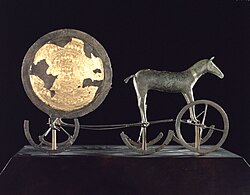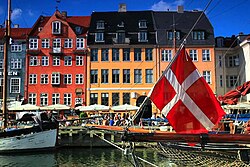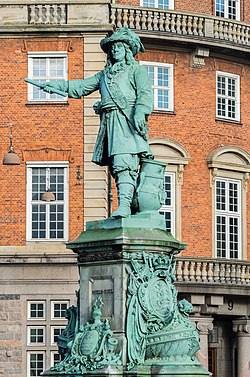See all articles relating to: Denmark

Denmark is a small Nordic country with a rich history. From the late 8th century C.E. to the 11th, the area was inhabited by Vikings, known for their advanced seafaring capabilities and fierce warrior culture. In later centuries, Denmark played an important role in European history, including its involvement in the Protestant Reformation and its military alliances during World War I and World War II. Throughout the country's history, Denmark has been home to several notable figures, including Hans Christian Andersen, Søren Kierkegaard, Tycho Brahe, Niels Bohr, and more recently, successful actors such as Mads Mikkelsen and Connie Nielsen. Today, Denmark is known for its high standard of living, modern cities, and thriving cultural scene, but its rich history and famous figures remain an important part of its national identity.
The regions of DenmarkThe regions of Denmark
Denmark is divided into five regions:
- Region Hovedstaden (Capital Region of Denmark)
- Region Midtjylland (Central Denmark Region)
- Region Syddanmark (Region of Southern Denmark)
- Region Sjælland (Region Zealand)
- Region Nordjylland (North Denmark Region)
The five regions are not used as administrative districts but primarily serve the purposes of healthcare administration, coordination of regional development, and overseeing social services.
Danish historyDanish history

Denmark was largely covered by glaciers during the last Ice Age and so was only very thinly populated until about 12,000 years ago. Agriculture was first undertaken here around 3000 BCE and the Bronze Age society which existed in Jutland and the neighboring islands by 1500 BCE was sophisticated enough to produce funerary ornaments such as the well-known Trundholm sun chariot. Yet, the region was technologically and culturally less advanced than the more southern parts of Europe and during Roman times there was little contact between Denmark and the Roman Empire. The region was also still theoretically in the Iron Age even by the time the Western Roman Empire came to an end.[1]
Denmark, like Norway and Sweden, burst into European history in the eighth century CE as the Vikings began raiding parts of Western Europe. The Danes came to be understood to be slightly different in their manners and customs to the Norse people of Scandinavia proper to the north. The English, for instance, referred to them specifically as 'Danes'. It was these Danes who were primarily responsible for raiding England and eventually established their own kingdoms there in the ninth century. The Danes reached the height of their power under King Cnut the Great in the early eleventh century, who for a time between 1028 and 1035 ruled Denmark, Norway and England.[2] By that time the Danes had largely adopted Christianity after a period of aggressive conversion during the tenth century.[3] However, the North Sea Empire of Cnut was short-lived as the Danes and Vikings were replaced as Europe’s pre-eminent military power by the Normans, themselves a Gallicized Norse people.
Under the Union of Kalmar, agreed in 1387 in Sweden, Queen Margaret of Denmark became ruler of Norway and Sweden as well. Denmark would subsequently exercise control over all of Scandinavia for a century and a half until Sweden broke from the Union in 1523.[4] This was right around the time that religious reformers such as Hans Tausen introduced the Protestant Reformation into Denmark. King Christian III adopted Lutheranism as the state religion of Denmark-Norway in the mid-1530s, making the Church of Denmark one of the world’s first Protestant national churches.[5]
Denmark was a second-tier power for much of early modern and modern European history. In the seventeenth and eighteenth centuries it was overshadowed by Sweden which emerged as the most powerful state in Scandinavia after the Union of Kalmar ended. Then in the nineteenth century Denmark lost much of its territory on the European mainland to Prussia in the Second Schleswig War or Prusso-Danish War of 1864.[6] Unwilling to countenance further losses of territory, the country remained neutral during the First World War, though the largest naval engagement of the conflict, the Battle of Jutland between the British Royal Navy and the German Kaiserliche Marine, was fought off of Danish shores. A similar effort to remain neutral during the Second World War was ignored and the Nazis occupied Denmark in the spring of 1940.[7] After the war Denmark became one of the first new accession states to the EEC in 1973.
See also:
Danish geographyDanish geography

Denmark’s geography is shaped by the sea. It is comprised of two distinct regions. The first of these is the Jutland Peninsula which comprises the mainland of Denmark and also divides the North Sea from the Baltic Sea, with the Skaggerak, the body of water north of Jutland toward Oslo in Norway, being the narrow passage through which all marine traffic flows between the two bodies of water. The rest of the country is a string of islands lying towards the Baltic Sea. The largest of these are Zealand, Funen and Lolland, but there are dozens of other islands of a significant enough size to be inhabited. The capital Copenhagen is primarily located on Zealand island and also the smaller neighboring island of Amager.[8] In 2000 the Øresund Bridge connecting Copenhagen to the Swedish mainland near Malmo opened. At eight kilometers in length it is the longest motorway and railway bridge in Europe. Nearly one in four Danes, some 1.4 million people, live in the capital Copenhagen. It is Denmark’s only major city, with Aarhus, Odense and Aalborg being the only other urban centers with more than 100,000 inhabitants.[9]
See also:
Researching family history in DenmarkResearching family history in Denmark
A great proportion of the most important records for the study of family history and genealogy in Denmark, such as censuses and other governmental records, are found in the Danish National Archives or Rigsarkivet.[10] The first censuses in Denmark and the Duchy of Schleswig-Holstein in the south of the country along the German border were carried out in 1769 and 1787. Beginning in 1834 these were carried out every five to ten years, generally speaking. Church records in a country which very quickly adopted Lutheranism following the Protestant Reformation of the early sixteenth century go back even further. King Christian IV issued a royal decree in the mid-1640s for the bishops of the Church of Denmark to begin keeping systematic records of births, marriages and deaths which occurred in their dioceses. Although a great many of these have subsequently been lost owing to the fact that only one copy was made by the head of each parish, some have survived, while there is an almost complete set of parish records for the entirety of Denmark between 1812 and 1814, at which time duplicates of the parish registers were produced.[11]
See also:
- Danish genealogy
- Danish immigration
- Danish emigration
- Danish archives
- Vital records in Denmark
- Birth records in Denmark
- Death records in Denmark
- Marriage records in Denmark
- Census records in Denmark
- Civil registrations in Denmark
- Church records in Denmark
- Newspaper records in Denmark
- Military records in Denmark
Danish ethnicityDanish ethnicity

Denmark is a predominantly ethnically homogeneous country, with most of the population identifying as ethnic Danes. However, in recent years, Denmark has become more diverse due to immigration, with people from a range of ethnic and cultural backgrounds now calling the country home. Some of the largest minority groups in Denmark include immigrants from Turkey, Iraq, Syria, and Somalia, as well as refugees and asylum seekers from countries such as Afghanistan and Eritrea. Additionally, Denmark is home to a small but significant population of people with mixed Danish and Greenlandic heritage, reflecting the country's historical ties to Greenland. Overall, while Denmark remains a largely homogenous society, its growing diversity is helping to shape the country's cultural landscape in new and exciting ways.
See also:
Danish surnamesDanish surnames

In Denmark, surnames were not widely used until the 19th century, which means that earlier records may refer to individuals by only their given name, patronymic name (a name derived from the father's name), or a nickname. However, in the 1800s, a law was passed requiring all citizens to adopt a hereditary surname, resulting in a wide variety of surnames that can be traced through generations of Danish families. When researching Danish family history, knowledge of common Danish surnames and their historical origins can be helpful in identifying ancestors and tracing family lines. For example, the surname "Jensen" means "son of Jens," and the surname "Nielsen" means "son of Niels".
See also:
Explore more about DenmarkExplore more about Denmark
- Danish Historical Record Collections on MyHeritage
- Have Nordic Ancestors? Count Yourself Lucky – Nordic Records are Amazing on the MyHeritage Knowledge Base
- Beginning Danish Research at Legacy Family Tree Webinars
- A Guide to Scandinavian Records on MyHeritage on the MyHeritage Knowledge Base
ReferencesReferences
- ↑ https://www.world-archaeology.com/issues/object-lesson-trundholm-sun-chariot/
- ↑ https://www.bl.uk/people/cnut
- ↑ https://www.worldhistory.org/article/1733/harald-bluetooth--the-conversion-of-denmark/
- ↑ https://www.britannica.com/place/Kalmar-Union
- ↑ https://museeprotestant.org/en/notice/protestantism-in-the-scandinavian-countries/
- ↑ https://www.britannica.com/event/German-Danish-War
- ↑ https://www.jstor.org/stable/26832821
- ↑ https://www.countryreports.org/country/Denmark/geography.htm
- ↑ https://www.statista.com/statistics/317244/largest-cities-in-denmark/
- ↑ https://en.rigsarkivet.dk/
- ↑ https://en.rigsarkivet.dk/explore/records-and-registries/


